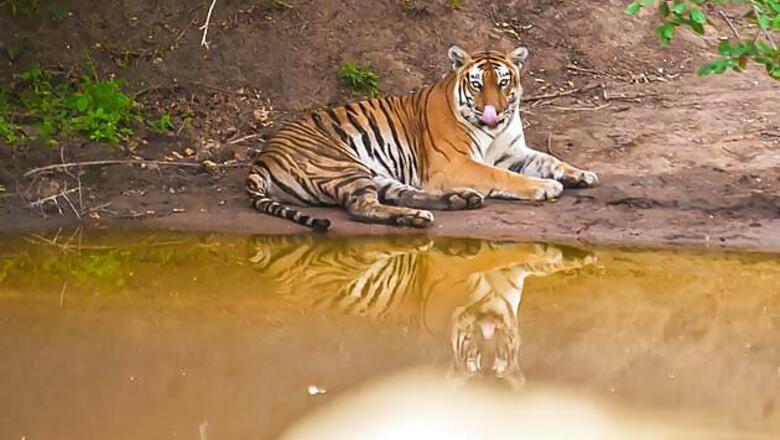
views
Bangalore: While the National Tiger Conservation Authority (NTCA) laments the growing number of tiger deaths in Indian reserves, there seems to be an increase in population in Karnataka. Virtually every month a transient tiger has been caught in the precincts of the Nagarhole Tiger Reserve.
For the record five stray tigers, including three robust males, have been caught in the periphery of the park over the last four and half months. This indicates that the tigers have been breeding well in the 684 sq km park, where the carnivore-prey density ratio is a sustainable 1: 50.
The last census put Karnataka on top of the tiger states, the state accounting for 300 numbers of the 1400-odd enumerated in the country. Encouragingly, tigers where noticed outside the five tiger reserves in the state, indicating the increasing number of tiger population.
Ironically, the growing numbers have put the forest department under severe pressure, as it has had to respond to distress calls from farmers who have often found tigers preying on their cattle. "I must admit that this is a happening place. I have barely been here for five months, but have caught five tigers which have been lifting cattle in adjacent villages," says R Gokul, Director, Nagarhole Tiger Reserve.
Of these two males have been released deep inside the forest and three were sent to the Jayachamarajendra (Mysore) and Bannerghatta zoological parks. Subsequently, one of them died in the Mysore zoo.
Catching a wild tiger is an arduous task. It gets even more difficult when intruding photo-journalists vie with each other to get a better picture. Ironically, reports in Friday's newspapers in Karnataka seem to suggest that the tiger (trapped and released deep inside the jungle) had leapt on an unsuspecting photographer.
It is common sense to stay clear of a cornered and enraged tiger. But this photo-journalist, in his desire to get a good image, didn't seem to care less for his and others' safety. Had the tiger sunk its canines into his flesh, he could well have perished. His imprudence could have possibly provoked the tiger into killing a villager. It would have been labeled a man-eater and been gunned down.
Thank God the adventurous photo-journalist (Ravishanker) is alive. Thank God the tiger, a ten-year-old male, survived too. But there is no escape for the forest personnel who were abused and stoned by irate villagers who had gathered to watch the tiger being captured on Thursday (Najaury 17, 2013). Two watchers suffered deep gashes while others suffered bruises in the stone-pelting incident.
The Nagarhole field staff has been put on high alert, as a tiger, injured in a territorial fight, has been seen limping around the periphery of the park. "We are hoping that it does not stray into villages. Again my staff will have to be employed to trap it," says R Gokul.
With the fire season looming large around the corner and faced with acute staff shortage, Gokul can ill-afford to put his men on tiger-trapping duty. Thanks to the callousness of Field Director, Project Tiger, BJ Hosmath, fire had consumed vast swathes (6000 hectares) of forest cover in the pristine park last year.
With the reserve already drying up due to an unusually early summer, there is fear that fire could be more devastating this year. In such an eventuality, the tiger and other species that abound in this park could be under peril. They could possibly move into adjacent villages. Man-animal conflicts, which have been on a unprecedented high already in the region, are bound to escalate.
With an acute shortage of fodder, elephants have been regularly raiding crop in adjacent farmlands and coffee estates. Driven out of their territory by stronger animals (survival of the fittest), tigers have frequently been devouring cattle. In one incident, a tigress killed eight cows and two goats in a coffee estate in Kanur (Kodagu) in one night. It went on a killing spree as it could not carry away the tethered animals.
The Karnataka government is aware of the grim situation. BJ Hosmath has hands-on experience of what prevails in Nagarhole Tiger Reserve. But nothing has been done to put things in right perspective. As a nation we want the critically endangered tiger to be saved from extinction.
The central government spends more than Rs 500 crore for protecting the tiger and its habitat. But in reality, the sands of time are running out for this beautiful animal.
You may ask, why? NTCA, wildlife biologists and conservationists insist that Nagarhole is arguably the best tiger park in the country. Teeming prey density and habitat make it an ideal reserve for the tiger to survive. Yet, Nagarhole has been neglected over the last four years.
It is shame that the Karnataka government hasn't appointed range forest officers in two of the seven ranges in the park. Two tigers were poached recently in the Mettikuppe range, but it does not have a ranger. A forester has been put in charge of the Veeranahosahlli range. Both these ranges are vulnerable to forest fires.
There is an acute 30 per cent shortage of field staff, mainly watchers/ trackers who are the ear, nose and eyes of our forests. Yet, Hosmath, who pulled every sting possible to retain his post as FDPT though he had completed his two-year term, has done precious little to address the staff shortage issues.
Intriguingly, wildlife biologist Ullas Karanth had recommended that Hosmath be retained as FDPT to the ministry of environment of forests (MoEF). Wonder why Mr Karanth backed Hosmath when everyone related to wildlife conservation in Karnataka, is aware of Hosmath's wildlife credentials.
It is disappointing that NGOs have utilized the prevailing situation to earn mileage and dollars. It is for conservation that NGOs sprung up, but their focus has shifted, perhaps by the lure of foreign funds. At the moment, two wildlife biologists (Karanth and Sanjay Gubbi), who have parted ways, have been vying for headlines! It is amusing that both send press releases to the media on the same issue.
In a scenario where the government has thrown a blind-eye and senior officers jockey to hold their positions, how do we save the endangered tiger. An increasing population and a shrinking habitat is a heady cocktail for man-animal conflicts.
Unless the government acquires land around the periphery of tiger reserves and substantially increase the buffer zone, farmers will have regular visitations from the tiger. Consequently, more displaced tigers will be sent to zoos.
Though this story relates only to Nagarhole, it holds good for the other tiger reserves - Bandipur, Bhadra, Anshi-Dandeli and BRT - in Karnataka.



















Comments
0 comment